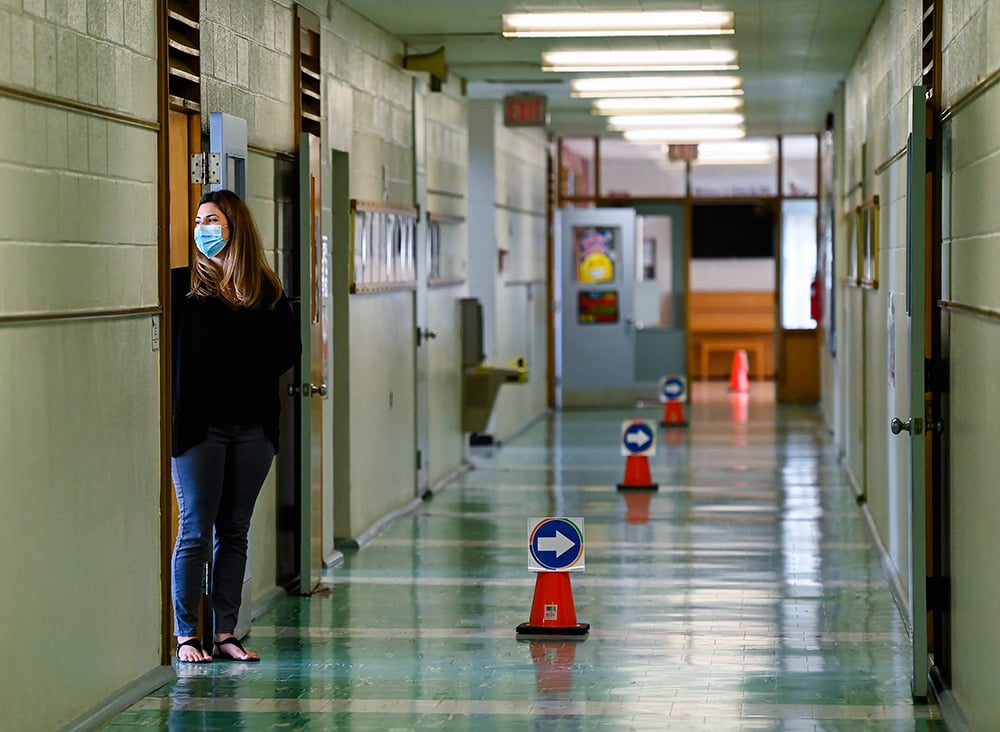Anxieties among Canadian teachers are high and rising. Confronted with rising second wave COVID-19 cases, some provinces extended holiday school closures.
Meanwhile, many teachers have had to put aside concerns about their own health and safety with in-person learning.
In Canada, teachers aren’t currently among the first in line to be vaccinated, despite the Canadian Teachers’ Federation call for teachers to be considered frontline workers and given priority for vaccination. The federation cites concerns with poor ventilation and insufficient physical distancing, among other issues.
Teachers have been in a constant state of unease since schools closed in March. With little in the way of preparation or training, they were called upon to move their classrooms and teaching online. Alongside this growing unease, they had to adjust their home spaces to handle new details. Some had to teach online while supporting their own children’s participation in virtual classrooms.
When teachers returned to classrooms in September, they were required to juggle new safety protocols, help create socially distanced classrooms and oversee children’s health practices such as hand washing.
Some have had to improvise hybrid in-class routines where they teach while some children attend virtually.
This fall, we held focus group discussions with 20 teachers in one of the Atlantic provinces to ask how teachers felt about their roles as educators and about the teaching challenges in a pandemic. This was part of a larger research project in collaboration with teachers and researchers in Canada, Finland and the United Kingdom that promotes children’s voices and digital storytelling.
Teachers we interviewed about their classroom experiences expressed fears for their own health and their families, worries about the impacts of social distancing in classrooms and concerns about insufficient teaching tools and resources.
Teachers said there has been no change in the tools they are provided to support children’s educational and mental health needs.
Caught in the crossfire between health advisories and government or school board indecisiveness or inaction, teachers were often left standing ill-equipped and feeling unsupported in the frontlines of this pandemic.
In interviews, teachers described their emotional and physical strain. One stated hand-washing regulations had “shredded her hands to bits.”
Another anguished teacher with compromised health feared for students’ emotional needs. Some young students with varying levels of physical independence and emotional maturity or still learning home and school boundaries frequently touch teachers or require hands-on help. The teacher knew she needed to sharply dissuade physical proximity, and this could be overwhelming for some students.
Even teachers who were well prepared and experienced in responsive teaching were not ready for a pandemic, and the resulting pivot to teaching online. The range of teaching approaches they have developed has been vast, from homemade and interactive videos to taking learning outdoors.
During our focus group discussions, teachers brought forth powerful metaphors.
In one of our in-person but distanced sessions, one teacher brought a Rubik’s Cube and explained that while she knew teaching in a pandemic could be done, she had no idea how to solve the puzzle. The cube resonated with all the teachers as an analogy for their frustrations.
Another shared a set of Matryoshka nesting dolls that represented the layers of curriculum, protocols and the many levels and complexities of teaching. Each doll opened to reveal another problem. The teacher explained that the last doll represented the children in her classroom who seem to be given the lowest priority on the national stage amidst discussions of the national economy and other priorities.
Her response sparked emotion in the group. Other teachers recalled the social inequities some children face daily and brought to mind students who they knew would be affected by the absence of school-provided breakfast and lunches during the lockdown.
During our meetings and interviews in October, teachers relayed how they navigated the new demands. By our December interviews, our conversations were dominated by teachers’ experiences of constant stress and anxiety. One teacher pointed to “teacher fatigue,” and how the many extra safety procedures and protocols were wearing teachers down. She likened it to “death by a thousand cuts.”
All teachers had added many new elements to their frontline worker duties — extra hand washing, disinfecting desks, constant reminders to socially distance. All of these measures resulted in lost preparation time, lost class time or missed lunches.
While teacher education programs in Canada address teaching with digital tools, their focus is in-person classroom teaching. With the COVID-19 lockdown, Canadian teachers struggled. They searched for online teaching skills and approaches while creating meaningful digital engagement and learning strategies.
Teachers knew that it would not be possible for all children and families to have the means to wake up one day and go to school virtually. They knew children from vulnerable contexts were more seriously impacted by the pandemic: for example, digital access was not universal and parents from lower-income households particularly faced challenges managing home schooling with their own work.
Discussions with teachers were also full of the optimism teachers are recognized for. Teachers mentioned instances of growing cohesion and community in the classroom, and how these vital connections were nurtured with students before and during present COVID-19 lockdowns and restrictions. Another teacher mentioned how, as a result of parents following provincial advisories to keep sick children at home, occasionally smaller classes prevailed.
With the rise of COVID-19 cases, teachers are taking on this frontline fight as they continue to cultivate their learning about teaching online and in hybrid contexts and their strategies for managing risks in schools.
As teachers continue to teach in both physical classrooms and online, the uncertainties around the pandemic continue.
If COVID-19 has any bright silver lining, it has made the public vitally aware of children’s socio-emotional needs and the critical and growing role of teachers as heroes in the pandemic.
![]()
![]()
Read more: Education, Coronavirus

















Tyee Commenting Guidelines
Comments that violate guidelines risk being deleted, and violations may result in a temporary or permanent user ban. Maintain the spirit of good conversation to stay in the discussion.
*Please note The Tyee is not a forum for spreading misinformation about COVID-19, denying its existence or minimizing its risk to public health.
Do:
Do not: